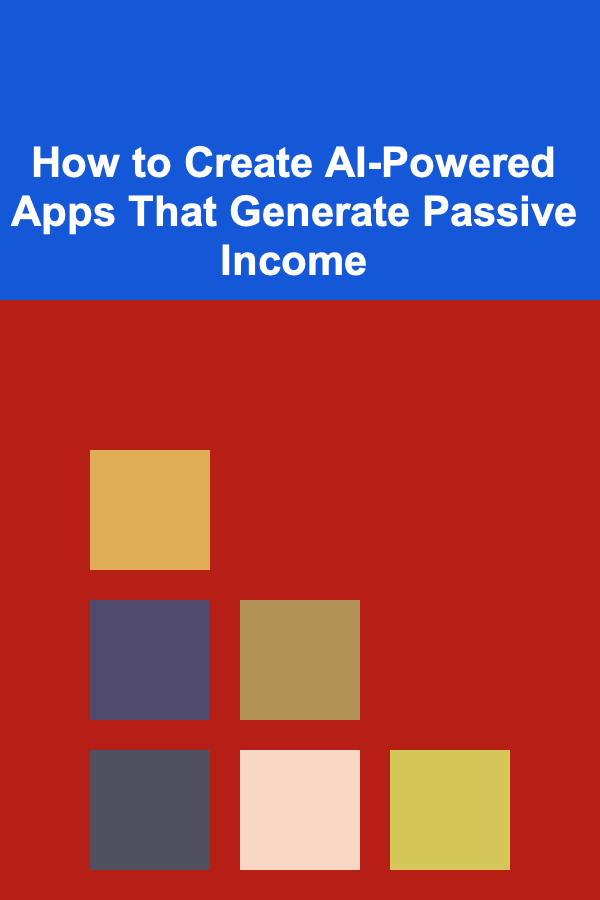
How to Create AI-Powered Apps That Generate Passive Income
ebook include PDF & Audio bundle (Micro Guide)
$12.99$6.99
Limited Time Offer! Order within the next:

In the rapidly evolving tech landscape, Artificial Intelligence (AI) is no longer a futuristic concept; it's a transformative force driving innovations across industries. For developers and entrepreneurs, AI presents a lucrative opportunity to create intelligent applications that solve problems, enhance productivity, and generate passive income.
Building AI-powered apps that generate passive income requires a strategic approach to leveraging AI technologies, selecting the right tools, understanding user needs, and choosing a monetization strategy that can deliver long-term revenue. Whether you're interested in creating a subscription-based service, a one-time purchase app, or a platform that earns money while you sleep, AI-powered apps can be a powerful vehicle for financial success.
This guide will walk you through the key steps required to create AI-powered applications, from ideation to monetization, and provide actionable strategies for building sustainable passive income streams.
Understanding the Concept of Passive Income in the Context of AI-Powered Apps
Before diving into the technical and business aspects, it's essential to understand what passive income means in the context of app development. Passive income refers to earnings derived from an asset that requires little to no effort to maintain once it's set up. In the case of AI-powered apps, passive income can come from various sources:
- Subscription Fees: Regular payments from users who access your app's services.
- Ad Revenue: Earnings from advertisements displayed within your app.
- In-App Purchases: Selling digital goods or premium features.
- Affiliate Marketing: Earning a commission by recommending third-party products or services.
AI-powered apps can generate passive income by automating tasks, providing services, or offering features that deliver consistent value over time. The key to success lies in creating an app that users find valuable, solving a real problem, and then setting up a business model that enables continuous earnings with minimal intervention.
Step 1: Identifying the Right Problem to Solve with AI
The foundation of any successful AI-powered app is a clear understanding of the problem you're trying to solve. The application must be tailored to address specific pain points for users or businesses. Here are some effective ways to identify promising opportunities:
1.1 Market Research
Conduct thorough market research to identify gaps in the market. Explore various industries and assess how AI can bring innovation or improvements. Some of the most popular industries benefiting from AI apps include:
- Healthcare: AI is transforming the healthcare industry by offering applications for personalized medicine, diagnostics, and virtual health assistants.
- Finance: AI-driven apps for budgeting, financial planning, fraud detection, and stock market prediction.
- E-Commerce: AI-powered recommendation engines, chatbots, and customer support tools.
- Education: Personalized learning platforms, virtual tutors, and language learning apps.
- Productivity: Task automation, time management tools, and smart assistants.
- Entertainment: AI-generated content, personalized recommendations, and interactive gaming experiences.
By exploring these industries and understanding user pain points, you can develop an app that leverages AI to provide a meaningful solution.
1.2 Identify User Needs
Once you've selected an industry, it's time to narrow down the specific needs of your target audience. Look for problems that can be solved effectively through AI, such as:
- Automating repetitive tasks (e.g., scheduling, data entry, customer inquiries)
- Providing insights and predictions based on data (e.g., financial forecasting, health risk assessments)
- Enhancing user experience (e.g., personalized recommendations, adaptive learning paths)
- Improving efficiency or productivity (e.g., optimizing supply chain management, virtual assistants)
By focusing on real-world problems, you can develop an app that users are more likely to adopt and continuously use, increasing the chances of long-term passive income.
Step 2: Choosing the Right AI Technologies and Tools
AI applications rely heavily on data and sophisticated algorithms. To build an effective AI-powered app, you'll need to select the right tools and technologies that align with your product's objectives. Here are the core components you'll need to consider:
2.1 Machine Learning Frameworks
To build AI-powered apps, you'll need a machine learning (ML) framework that can handle data processing, model training, and deployment. Some of the most popular frameworks include:
- TensorFlow: An open-source ML framework developed by Google, widely used for building deep learning models. TensorFlow is suitable for large-scale AI applications.
- PyTorch: A flexible ML framework developed by Facebook, known for its ease of use in research and production environments.
- scikit-learn: A Python-based library for machine learning that is ideal for smaller projects, offering easy-to-implement models like regression, classification, and clustering.
- Keras: A high-level neural networks API that runs on top of TensorFlow, designed to make deep learning easier to implement.
2.2 Natural Language Processing (NLP) Libraries
If your app deals with text or speech, NLP tools will be crucial. NLP enables AI systems to understand, interpret, and generate human language. Popular NLP libraries include:
- spaCy: A powerful library for industrial-strength NLP tasks, including part-of-speech tagging, named entity recognition, and text classification.
- NLTK: A library that provides easy-to-use interfaces for processing linguistic data, often used for educational purposes or research.
- GPT (Generative Pretrained Transformer): A state-of-the-art NLP model, particularly useful for building chatbots, content generation, and other text-based applications.
2.3 Cloud AI Services
If you lack the resources to build AI models from scratch, cloud-based AI services can save time and effort by providing pre-trained models and easy-to-use APIs. Leading cloud platforms include:
- Google Cloud AI: Offers pre-built models for image recognition, translation, text analysis, and more.
- Microsoft Azure AI: Provides cognitive services for language understanding, computer vision, and AI decision-making.
- Amazon AWS AI: Features services like Amazon Rekognition for image and video analysis and Amazon Polly for text-to-speech functionality.
Using cloud-based services can significantly reduce development time, enabling you to focus on building the app's functionality and user interface.
Step 3: Developing the AI-Powered App
Now that you've identified the problem, chosen the technology stack, and prepared the necessary tools, it's time to start building the AI-powered app. Here's a step-by-step process for creating the app:
3.1 Design a User-Friendly Interface
The app's user interface (UI) should be simple, intuitive, and visually appealing. Even though your app is powered by AI, users should be able to interact with it without needing technical expertise. Keep these principles in mind:
- Simplicity: Avoid overcomplicating the design. Focus on the core functionality.
- Navigation: Make it easy for users to navigate and understand the app's features.
- Performance: Ensure that the app loads quickly and functions smoothly.
- Mobile Compatibility: Ensure that the app works well on both desktop and mobile devices.
3.2 Develop Core AI Features
Develop the core AI-driven functionalities, such as:
- Data Processing: Depending on the type of data your app will handle, develop processes for cleaning, transforming, and feeding the data into your AI models.
- Model Training: Train your AI models using labeled datasets. Experiment with various algorithms and tweak hyperparameters to optimize model performance.
- Prediction and Inference: Implement logic to use trained models to make predictions or decisions based on new data provided by users.
3.3 Testing and Optimization
AI models need rigorous testing to ensure they are accurate and reliable. Perform the following:
- Cross-Validation: Test your model using multiple data subsets to avoid overfitting.
- A/B Testing: Run tests with real users to see how different versions of the app perform.
- Performance Tuning: Continuously optimize your app's AI models and algorithms to handle a large number of users efficiently.
Step 4: Monetization Strategies for Passive Income
Once the AI-powered app is developed, it's time to figure out how to generate passive income. Several monetization strategies can help you achieve this:
4.1 Subscription Model
A subscription model is one of the most common ways to generate passive income. Users pay a recurring fee to access the app's premium features or services. Some benefits of the subscription model include:
- Predictable Revenue: Subscription fees ensure a steady stream of income over time.
- Scalability: As your user base grows, so does your revenue.
You can offer different pricing tiers, such as a free version with limited features and premium plans with enhanced capabilities.
4.2 Ad Revenue
Displaying advertisements within your app can be a lucrative revenue stream. Platforms like Google AdMob or Facebook Audience Network make it easy to integrate ads into your app. Revenue is typically earned based on:
- Impressions: Each time an ad is shown to a user.
- Clicks: When users click on an ad.
While ad revenue can be passive, it may require a large user base to be substantial. Keep in mind that excessive ads can degrade the user experience, so balance is key.
4.3 In-App Purchases
In-app purchases are another popular method of monetization. Offer users the option to buy premium features, digital goods, or enhanced functionality within the app. This strategy works particularly well for apps with game-like elements or specialized tools (e.g., additional filters, analytics, or insights).
4.4 Affiliate Marketing
Affiliate marketing allows you to generate passive income by promoting third-party products or services within your app. When users click on your affiliate links and make a purchase, you earn a commission. This can be an effective strategy if your app has a large, engaged audience.
Step 5: Marketing and Scaling Your AI App
To generate consistent passive income, your AI-powered app must attract a steady stream of users. Effective marketing and user acquisition strategies include:
- Social Media Marketing: Leverage platforms like Instagram, Facebook, and Twitter to reach potential users.
- App Store Optimization (ASO): Ensure your app is discoverable in app stores by using relevant keywords, attractive screenshots, and compelling descriptions.
- Referral Programs: Encourage existing users to invite friends and earn rewards for doing so.
- Influencer Marketing: Partner with influencers or bloggers to promote your app to a wider audience.
Additionally, as your user base grows, ensure your app scales effectively by optimizing performance, expanding server capacity, and handling high traffic loads.
Conclusion
Creating AI-powered apps that generate passive income requires a combination of technical expertise, market research, strategic planning, and continuous optimization. By identifying the right problem to solve, leveraging the power of AI, and selecting an effective monetization strategy, you can build a sustainable and profitable business that generates revenue while you sleep.
However, success doesn't happen overnight. It requires continuous iteration, user feedback, and a focus on delivering real value. With patience, creativity, and dedication, AI-powered apps can provide a pathway to passive income and long-term financial success.
Reading More From Our Other Websites
- [Reading Habit Tip 101] Using Annotation and Mind-Mapping to Transform Any Book into a Knowledge Mine
- [Home Maintenance 101] How to Inspect and Maintain Your Home's Termite Protection
- [Home Family Activity 101] How to Plan a Local "Foodie" Tour with Kids
- [Organization Tip 101] How to Set Up a Family Talent Show for Entertainment
- [Home Maintenance 101] How to Choose the Best DIY Home Repair Projects for Beginners
- [Organization Tip 101] How to Create a Kid-Friendly Reading Corner
- [Beachcombing Tip 101] Step-by-Step Guide: Crafting Your First Driftwood Wall Sculpture
- [Screen Printing Tip 101] DIY vs. Professional: When to Print Posters Yourself and When to Hire a Shop
- [Gardening 101] 10 DIY Organic Pest Repellents Every Gardener Should Try
- [Home Renovating 101] How to Update Your Home's Curb Appeal with a Small Budget

How to Organize Veterinary Visits and Appointments
Read More
How to Plan Your Meals with a Grocery Shopping Checklist: An Actionable Guide
Read More
How to Develop Blockchain-Based Games (GameFi)
Read More
The Art of Stock and Broth: Building Flavor from the Ground Up
Read More
How to Create Engaging Printable Board Game Storylines
Read More
How to Choose an Anesthesiologist: Key Considerations
Read MoreOther Products

How to Organize Veterinary Visits and Appointments
Read More
How to Plan Your Meals with a Grocery Shopping Checklist: An Actionable Guide
Read More
How to Develop Blockchain-Based Games (GameFi)
Read More
The Art of Stock and Broth: Building Flavor from the Ground Up
Read More
How to Create Engaging Printable Board Game Storylines
Read More